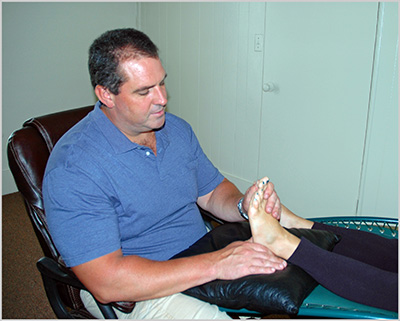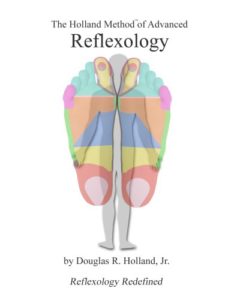What Is Reflexology?
Reflexology is the unique modality that uses pressure from the thumb and fingers to strike reflexes in the feet that detect congestion, unlock and reopen communication and impart the need for responsible action of all body members to reach homeostasis.
The theory of reflexology is that due to tension, toxins and stress, individual organs, glands and parts of the body either lose contact with superior vitals, or build up defense mechanisms that hinder normalization and good health.
“The goal of the reflexologist is to find and unblock congestion and re-establish communication among wayward members to achieve homeostasis.” – Doug Holland Jr

See how reflexology can do wonders for plantar fasciitis.
From Where and When Did Reflexology Spring?
Throughout world history there are fragmented hieroglyphs of individuals who appear to be pressing on points of the feet and hands (or who may be looking to the feet and hands) to help with pain and sickness as well as other diseases.
These hard-to-discern pieces of archeology point to possibilities that the feet or hands had some profound aspect on one’s health or were staples in general well-being.
Some of these hieroglyphic recordings may go back as far as five thousand years ago.
One example is an Egyptian hieroglyph from approximately 2330 B.C., used repeatedly in various reflexology publications and studies, that some say is the clearest expression of a possible pressure treatment to the feet and hands.
A pictograph from an Egyptian tomb (known as ‘The Physician’s Tomb’) depicts four persons with one appearing to be treated with pressure to the foot and another with pressure to the hand.
Other examples through the ages include: Doctors Adamus and A’Tatis and later Dr. Ball who published medical dissertations in the 16th century on zone therapy.
Benvenuto Cellini (1500-1571) was known as a great Florentine sculptor who used acupressure on his fingers and toes; as well as American President James A. Garfield (1831-1881) who used the applying of pressure on the feet to relieve pain.
Reflexology in modern times
Dr. William Fitzgerald, Dr. H. Bressler, Dr. Edwin Bowers, Dr. Riley, Eunice Ingham, Doreen Bayley as well as many others stumbled upon the uniqueness of this modality as well as trying to understand it clinically and document their findings.
With thousands of trial-and-error sessions, a pattern of reflexes was discovered primarily in the feet. Zone Theory (what this practice was known as until the 1960′s) evolved into reflexology, the term we are all familiar with today.
Other reflexologists the world over have developed their own theories through practical and scientific experience while perfecting their own art of where they believe the reflexes lie and how they affect the physiology of the body.
However, it seems to be a simple rearranging of the Zone theory over and over again.
Zone Theory has been the most prevalent theory in the United States for almost the last hundred years.
Most reflexologists still hold the belief that reflexes are found in ten zones of the feet, but may differ as to where the specific reflexes are located on their own charts.
Just recently, however, Zone Theory has been challenged by the Dominant Theory of reflexology and this may truly change the direction of research that reflexologists map and experiment with.
Doug’s reflexology book delves into further detail on this subject.

Reflexology School and Education Class Free To View
My Reflexology School DVD is now free to watch on YouTube. I want everyone to learn about reflexology and how to practice at home or professionally for making money.
The video complements my reflexology textbook that guides you through the step-by-step learning process on how to do reflexology professionally. We used this same textbook in class along with the video you see above.
Learning Reflexology At Home
For years we were a registered reflexology school in the state of Ohio teaching at the college level. But now, we want everyone to learn the benefits of reflexology within the comfort of their own home.
After working on thousands of people over the last 20years I feel more than ever that you can help people to have a healthier life through foot reflexology.
If you study my Reflexology textbook and practice what you see on the school video with real people, you will have the basics needed to change lives.
What reflexology school would you recommend since you no longer provide certification?
It really depends on what your goals are. I knew from the first time I received a reflexology treatment that I wanted to attend the school that my reflexologist went to.
I was so pleased with the results of the first treatment that I enrolled in the International Institute of Reflexology within a month (that was in 2000).
I figured this: if he could have helped me in such a short period of time using massage acupressure on my feet, it should help my family as well.
Helping my family and friends was my first reason for enrolling in a reflexology school. Financial was my second.
What if hundreds of people would pay me to work on their feet? Could I give up my construction company and help people full time?
Reflexology has been a cherished career. I really love helping people feel better.
Yes we have to pay the light bill, but watching people improve health-wise because of your skill is priceless.
So here is what I recommend: Find a reflexologist that really is skilled, and then ask what school they attended.
Why did you create your own method of reflexology?
You will find that most schools give you a basic foundation in understanding and practice. It certainly can build confidence in your modality. But it is not necessary unless you need to be certified.
With that said, I believe most of what is learned is in the field of practice. That means DOING. Get out there and learn while you work.
Also, educate yourself with as many books and videos that you can squeeze into your busy life.
Back in 2000, if I would have had means to a free reflexology training video (like the one I posted for free) along with a textbook geared toward becoming a professional reflexologist, I think I would have leaped for joy.
So you don’t need to be certified as a reflexologist in Ohio?
Reflexology Certification is not needed in most states. So check with your local government about practicing reflexology without a license.
Many states simply exempt reflexology as a separate modality from massage practice.
Reflexology is more art then dogmatic movements. I tell people to never do this or that in my book and videos, however, that’s just a basic training method for test taking.
Just because a practitioner passes the test does not make them a good reflexologist.
Pass the test and move on to reality.
It simply takes time to develop one’s art of reflexology. The more hands and feet you work on, the greater your knowledge of how reflexes really work.
How do you practice reflexology?
I was taught to use light pressure during a reflexology treatment. It was heresy to think that more pressure was needed to strike reflexes to bring about a health response.
Nothing could be further from the truth. Lazy reflexologists love going easy because it saves their hands. I, on the other hand, will walk out of a practice that plays gentle with my feet.
I call it the Foo-Foo treatment or the ‘Cruise Ship’ treatment.
Here is my reasoning:
Increased pressure with each visit opens up the autonomic nervous system on an unprecedented scale. Pressure stresses the sympathetic nervous system in ways we are just beginning to understand.
Without pain from high pressure, results will be weak and short-lived.
I’m not advocating a torture session, rather purposeful pain that leads to a positive health response.
And that was one reason I wrote my own version.
Another reason for a fresh approach was that I learned that the Zone Theory really did not fit the reflex mapping I observed in my clients over the years.
It became clear that some reflexes simply dominate all other reflexes. Thus I wrote about the Dominate Theory of Reflexology in 2009. Many reflexologists agreed and thus my book was born.
Think too, of all the experience a practitioner has. Is his experience and knowledge valuable? Is it worth spending money on?
I would pay for multiple reflexology treatments from a single reflexologist and learn while being worked on.
The $35.00 per treatment was worth every penny. You could feel what it was like to have your reflexes burning while you were learning. Hey I like that!
Some of my students are very successful. They went into new territory using fresh means.
Example: One student works primarily on Amish residents in Middlefield, Ohio. He goes to their home and the Amish line up. He said the Amish really appreciate this modality in its’ rawest form.
Here in Ohio (2018), there is no need for a reflexology license. So, a person can learn as they go and be successful.
What does it take to be successful in reflexology?
Hard work is key. Caring is key. Living simply is key. Accepting a modest income is key. And last but not least, results are key.
Ego aside, I believe I could impress some of the best reflexologists in the world and yet I am just paying my bills like the rest.
I have a good, modest life. I focus more on healthy living than rich living. I sleep good at night. My family is spiritually awesome, and I am still married to the same woman who bore my children. Could life be better?
Doug Holland, LMT
Doug is a licensed massage therapist in Ohio with 900 hours anatomy and physiology class hours.
Doug is also a certified reflexologist. He became certified in reflexology at the International Institute of Reflexology (2000) as well as becoming certified as an Advanced Integrative Reflexologist at the Advanced Integrative Medical Institute in Washington D.C. In 2001. He is one of only 50 reflexologist in the world certified by an accredited school by three doctors for reflexology master.
